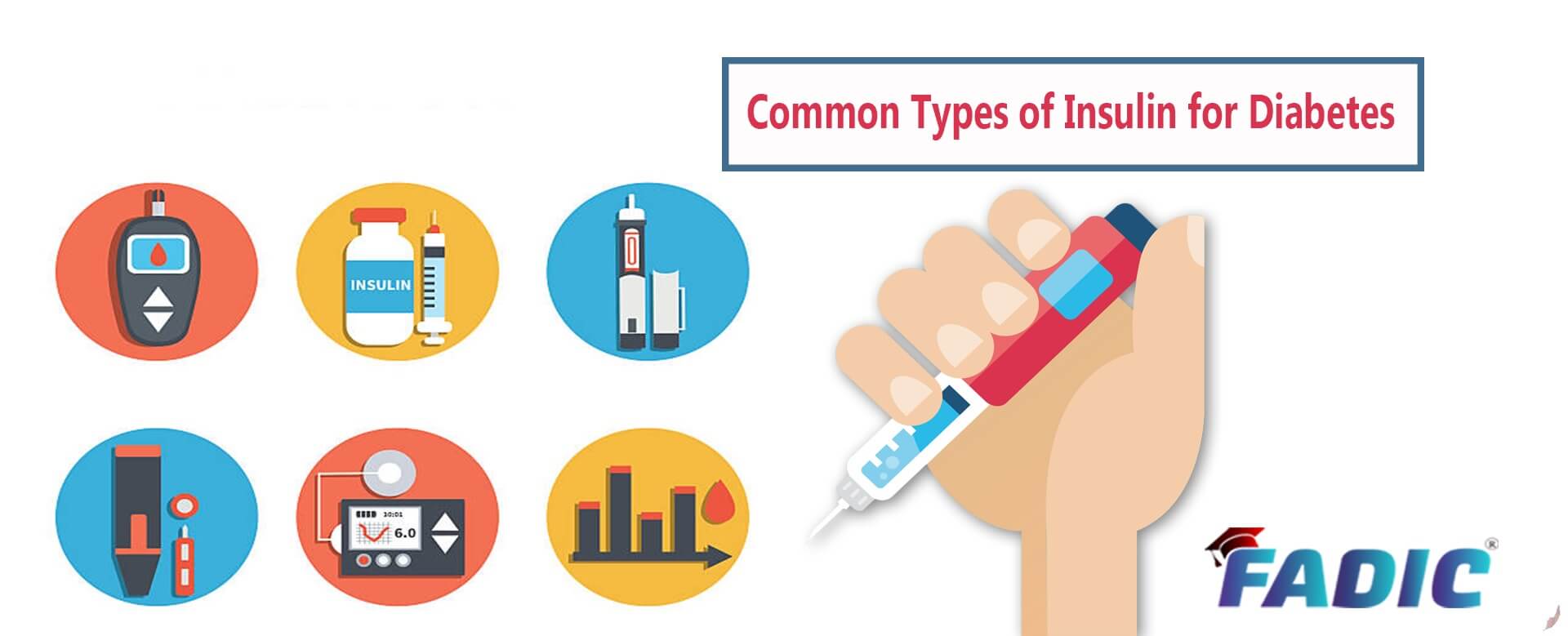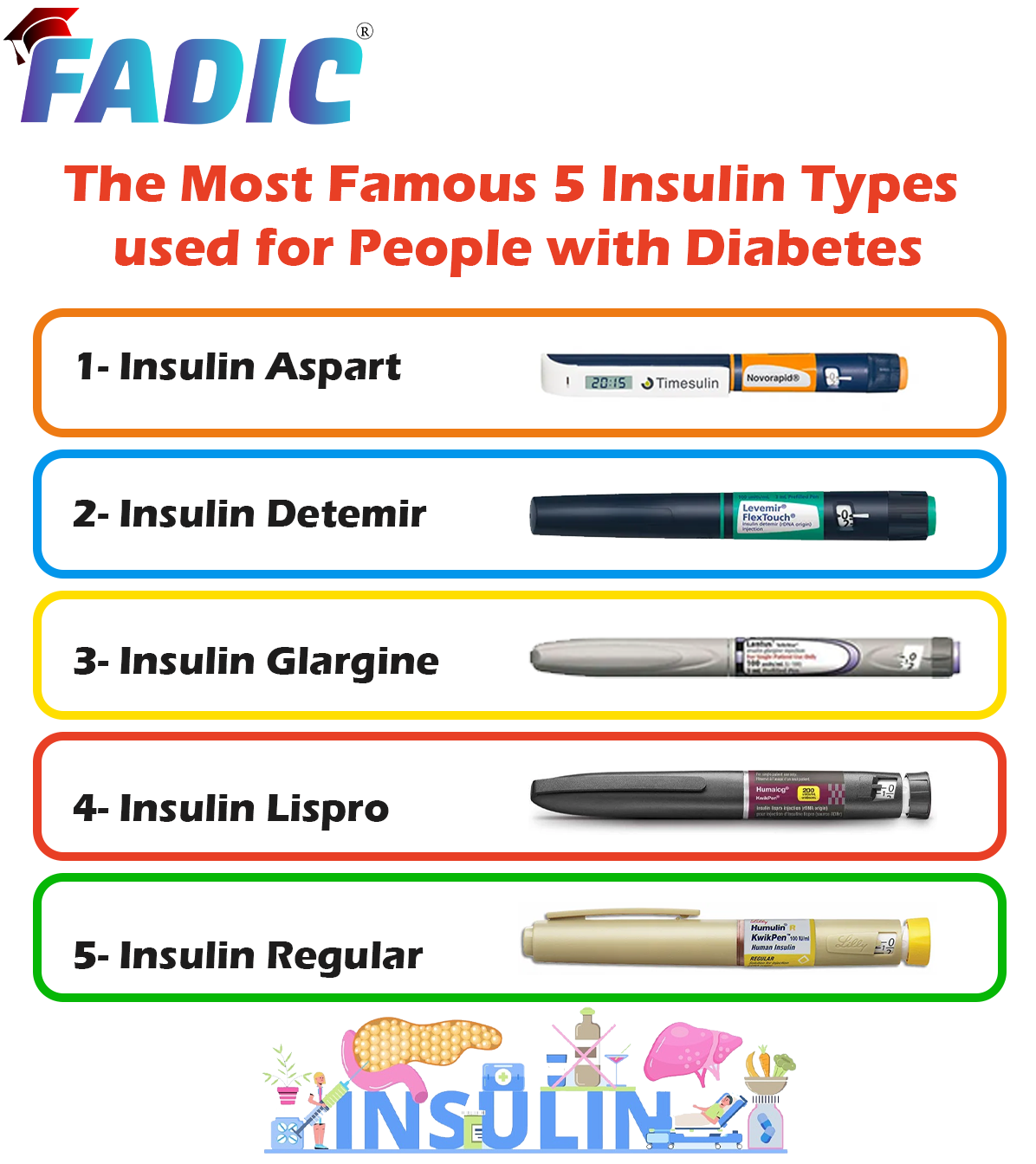A Guide on Insulin Types for People with Diabetes
A Guide on Insulin Types for People with Diabetes

The Most Famous 5 Insulin Types used for People with Diabetes are:
1- Insulin Aspart 💊
2- Insulin Detemir 💊
3- Insulin Glargine 💊
4- Insulin Lispro 💊
5- Insulin Regular 💊
Insulin Aspart
- Brand Names: NovoRapid
- Therapeutic Category: one of the Insulin Types, Rapid-Acting
- Dosage Forms: Solution, Subcutaneous
- Use:
- Labeled Indications: Diabetes mellitus, types 1 and 2: Treatment of type 1 diabetes mellitus and type 2 diabetes mellitus to improve glycemic control
- Off-Label: Diabetic ketoacidosis (mild to moderate)/ Gestational diabetes mellitus/ Hyperglycemia during critical illness
- Dosing : Adult: Dosage must be titrated to achieve glucose control and avoid hypoglycemia. Adjust the dose to maintain premeal and bedtime glucose in the target range.
- Diabetes mellitus, type 1: Initial TDD: 0.4 to 0.5 units/kg/day
- Usual TDD maintenance range: 0.4 to 1 units/kg/day in divided doses
- Pediatric : Initial total insulin dose: SubQ: 0.2-0.6 units/kg/day in divided doses
- Usual maintenance range: SubQ: 0.5-1 unit/kg/day in divided doses.
- Dose Adjustments
- Renal Impairment. No dosage adjustment.
- Hepatic Impairment: No dosage adjustment.
- Adverse Drug Interaction:
Headache/ hyporeflexia/ Severe hypoglycemia/ Nasopharyngitis - Pharmacodynamics/Kinetics:
- Onset of action: 0.2 to 0.3 hours
- Peak effect: 1 to 3 hours (Novolog)
- Duration: 3 to 5 hours
- Half-life elimination: SubQ: 81 minutes (Novolog)
- Important Notes:
- The most common adverse effect of insulin is hypoglycemia
- Hypoglycemia may result from changes in meal pattern (e.g., macronutrient content, the timing of meals), changes in the level of physical activity, increased work or exercise without eating, or changes to coadministered medications
- Shouldn’t be used if it has been frozen.
- Pregnancy & Lactation: Pregnancy category B/ present in breast milk
- Drug safety issue:
NovoLOG may be confused with HumaLOG, HumuLIN R, Nimbex, NovoLIN N, NovoLIN R, NovoLOG Mix 70/30
Insulin Detemir
- Brand Names: Levemir
- Therapeutic Category: one of Insulin Types, Long-Acting
- Dosage Forms: Solution, Subcutaneous
- Use:
- Labeled Indications: Diabetes mellitus, types 1 and 2: Treatment of type 1 diabetes mellitus and type 2 diabetes mellitus to improve glycemic control
- Dosing : Adult: Insulin detemir must be used concomitantly with rapid- or short-acting insulins (i.e., multiple daily injection regimens)
- Initial TDD: 0.4 to 0.5 units/kg/day
- Usual TDD maintenance range: 0.4 to 1 units/kg/day in divided doses
- Dosage must be titrated to achieve glucose control and avoid hypoglycemia
- Pediatric Usual maintenance range: SubQ: 0.5 to 1 unit/kg/day in divided doses; doses must be individualised
- Dose Adjustments
- Renal Impairment: No dosage adjustment.
- Hepatic Impairment: No dosage adjustment.
- Adverse Drug Interaction:
Headache/ Hypoglycemia/ abdominal pain - Pharmacodynamics/Kinetics:
- Onset of action: 3 to 4 hours
- Peak effect: 3 to 9 hours
- Duration: Dose-dependent: 6 to 23 hours
- Important Notes:
- The most common adverse effect of insulin is hypoglycemia
- Use caution in patients at risk for hypokalemia (e.g., loop diuretic use). Monitor serum potassium and supplement potassium when necessary.
- Pregnancy & Lactation: Pregnancy risk factor B/ present in breast milk
- Drug safety issue:
Levemir may be confused with Lovenox
Insulin Glargine
- Brand Names: Lantus
- Therapeutic Category: one of Insulin Types, Long-Acting
- Dosage Forms: Solution, Subcutaneous
- Use:
- Labeled Indications: Diabetes mellitus, types 1 and 2: Treatment of type 1 diabetes mellitus and type 2 diabetes mellitus to improve glycemic control
- Dosing : Adult: Insulin glargine must be used concomitantly with rapid- or short-acting insulins (i.e., multiple daily injection regimens)
- Initial TDD: 0.4 to 0.5 units/kg/day
- Usual TDD maintenance range: 0.4 to 1 units/kg/day in divided doses
- Dosage must be titrated to achieve glucose control and avoid hypoglycemia
- Pediatric Approximately one-third of the total daily insulin requirement is administered once daily; a rapid-acting or short-acting insulin should also be used to complete the balance
- Dose Adjustments
- Renal Impairment. No dosage adjustment.
- Hepatic Impairment: No dosage adjustment.
- Adverse Drug Interaction:
Hypertension/ peripheral edema/ Diarrhea/ Urinary tract infection - Pharmacodynamics/Kinetics:
- Onset of action: Lantus: 3 to 4 hours
- Peak effect: No pronounced peak
- Duration: Generally 24 hours or longer
- Important Notes:
- The most common adverse effect of insulin is hypoglycemia
- Use caution in patients at risk for hypokalemia (e.g., loop diuretic use). Monitor serum potassium and supplement potassium when necessary.
- Pregnancy & Lactation: Women who are stable on insulin glargine before conception may continue it during pregnancy/ present in breast milk
- Drug safety issue:
Insulin glargine may be confused with insulin glulisine
Lantus may be confused with latanoprost, Latuda, Xalatan
Insulin Lispro
- Brand Names: Humalog
- Therapeutic Category: one of the Insulin Types, Rapid-Acting
- Dosage Forms: Solution, Subcutaneous
- Use: Labeled Indications: Diabetes mellitus, types 1 and 2: Treatment of type 1 diabetes mellitus and type 2 diabetes mellitus to improve glycemic control
- Off-Label: Diabetic ketoacidosis (mild to moderate)/ Gestational diabetes mellitus
- Dosing : Adult: Dosage must be titrated to achieve glucose control and avoid hypoglycemia. Adjust the dose to maintain premeal and bedtime glucose in the target range.
- Diabetes mellitus, type 1: Initial TDD: 0.4 to 0.5 units/kg/day
- Usual TDD maintenance range: 0.4 to 1 units/kg/day in divided doses
- Insulin lispro must be used concomitantly with intermediate- or long-acting insulin
- Pediatric : Initial total insulin dose: SubQ: 0.2-0.6 units/kg/day in divided doses
- Usual maintenance range: SubQ: 0.5-1 unit/kg/day in divided doses.
- Dose Adjustments
- Renal Impairment: No dosage adjustment.
- Hepatic Impairment: No dosage adjustment.
- Adverse Drug Interaction:
Severe hypoglycemia/ Infusion site reaction/ Peripheral edema - Pharmacodynamics/Kinetics:
- Onset of action: SubQ: 0.25-0.5 hours
- Peak effect: SubQ: 0.5-2.5 hours
- Duration: SubQ: ≤5 hours
- Half-life elimination: 1 hour
- Important Notes:
- The most common adverse effect of insulin is hypoglycemia
- Hypoglycemia may result from changes in meal pattern (e.g., macronutrient content, the timing of meals), changes in the level of physical activity, increased work or exercise without eating
- Pregnancy & Lactation: Pregnancy category B/ present in breast milk
- Drug safety issue:
HumaLOG may be confused with HumaLOG Mix 50/50, Humira, HumuLIN N, HumuLIN R, and NovoLOG.
Insulin Regular
- Brand Names: Humulin R
- Therapeutic Category: one of the Insulin Types, Short-Acting
- Dosage Forms: Solution, Subcutaneous
- Use: Labeled Indications: Diabetes mellitus, types 1 and 2: Treatment of type 1 diabetes mellitus and type 2 diabetes mellitus to improve glycemic control
- Off-Label: Diabetic ketoacidosis (mild to moderate)/ Gestational diabetes mellitus/ Hyperglycemia during critical illness/ Hyperkalemia
- Dosing : Adult: Dosage must be titrated to achieve glucose control and avoid hypoglycemia. Adjust the dose to maintain premeal and bedtime glucose in the target range.
- Diabetes mellitus, type 1: Initial TDD: 0.4 to 0.5 units/kg/day
- Usual TDD maintenance range: 0.4 to 1 units/kg/day in divided doses
- Pediatric Initial dose: SubQ: 0.2 to 0.6 units/kg/day in divided doses.
- Usual maintenance range: 0.5 to 1 unit/kg/day in divided doses
- Dose Adjustments
- Renal Impairment: CrCl 10 to 50 mL/minute: Administer 75% of the usual dose and monitor glucose closely.
- CrCl <10 mL/minute: Administer 50% of the usual dose and monitor glucose closely
- Hepatic Impairment: No dosage adjustment.
- Adverse Drug Interaction:
Peripheral edema/ Erythema at injection site/ Hypoglycemia/ hypokalemia/ weight gain - Pharmacodynamics/Kinetics:
- Onset of action: SubQ: 0.25 to 0.5 hours
- Peak effect: SubQ: U-100: 2.5 to 5 hours
- Half-life elimination: SubQ: 1.5 hours
- Important Notes:
- The most common adverse effect of insulin is hypoglycemia
- Hypoglycemia may result from changes in meal pattern (e.g., macronutrient content, the timing of meals), changes in the level of physical activity, increased work or exercise without eating, or changes to co-administered medications
- Pregnancy & Lactation: Pregnancy category B/ present in breast milk
- Drug safety issue:
HumuLIN R confused with HumaLOG, Humira, HumuLIN 70/30, HumuLIN N, NovoLIN 70/30, NovoLIN R, NovoLOG.

Reading Materials:
- Download Summarized Library for Medical & Pharmacy Specialties Resources from this LINK
- Download NOW the Drug Information References from this LINK
- Register NOW in FADIC Applied Medical Resources Mini-Course, to learn how to think in a stepwise systematic approach through different resources.
- Drug Information Program is a MUST for every pharmacist.
- Evidence-Based Medicine Program will help you to validate any research paper.

 Log in
Log in Sign up
Sign up







